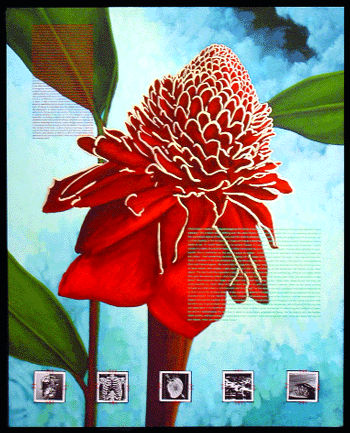Curator Karen Jones raises cogent questions with a broad range of works
EXCEEDING PAINT/EXPANDING PAINTING
Pratt Manhattan Gallery
144 W. 14th St., second fl.
Tue.– Fri. 10:30 a.m.-5:30 p.m.;
Sat. 12-5 p.m.
Through Jul. 16
212-647-7778
The “Exceeding Paint/Expanding Painting” exhibition at Pratt Manhattan Gallery poses several important questions: What is painting? What constitutes the “act” of painting? Is painting a political act? Is painting relevant in the 21st century?
The curatorial decisions made for “aim to engage a pedagogical discourse that attempts to answer some of these questions.”
At times, the answers are clear, but at other times not.
The range of work included is fairly broad—from Andy Warhol’s abject “Oxidation Painting,” a four-panel panel composed of urine and metallic pigment, to Arturo Herrera’s “Night Before Last II,” which encapsulates the spontaneity of abstract expressionism and a pop graphic cartoon sensibility directly painted onto the gallery walls.
Works by Louise Lawler are perhaps the most interesting because her use of photographs of famous paintings—including a Robert Rauschenberg combine—points to the treasure trove of 20th century breakthroughs in painting. The photos are mounted onto the bottom of glass paperweights. The lineage of the past 100 years’ art history is captured for viewers as they gaze at their own reflections into a magical sphere that provides more questions than answers.
Other tactics used by artists include the standard fare of installation art, with some achieving greater success than others. For example, Rina Banerjee’s overly complex “In this wishing jar, where pigments take flight and limbs reach…” feels like a hodge-podge of found objects somehow positioned into a floral arrangement. The piece includes references to Judy Pfaff’s sculpture, yet falls short and feels like work still attempting to articulate a cohesive voice.
In constrast, Katrin Sigurdardottir’s decisive “Untitled (four boxes)” explores landscape and speculative consumption within the art world. The work is composed of four miniature shipping crates, each unfolding an artificial landscape. The work has a sensibility similar to the commodified sculpture of Toland Grinell, yet offers a more thoughtful narrative to latch onto.
Straight-up painting is less evident here, and the examples available are not so interesting, with the very significant exception of the late David Wojnarowicz’s photographic collage “I Feel a Vague Nausea.” The placement of the work in the gallery could have been better considered; as it is, it hangs in an awkward location at the back. This is a shame since Wojnarowicz and a number of his contemporaries coming out of the 1980s East Village scene explored with excruciating detail the onslaught of AIDS, and the simultaneous blossoming of queer politics. Wojnarowicz did so with a profound narrative that runs throughout his prolific legacy of photography, painting, installations and writing.
I credit the curator Karen Jones for attempting to tackle profound questions about painting and for bringing together some compelling artists. I only wish she had be able to expand upon this discourse in a larger space where more consideration could be given to the works of art.
gaycitynews.com


































